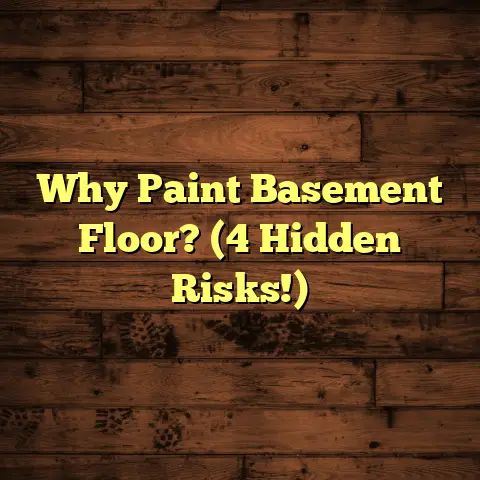Water Under Laminate: Help! (24-Hr Fix Needed!)
(Insert Image: Split screen showing a pristine laminate floor on one side and a water-damaged, warped floor on the other)
Ever walk into your house and get that sinking feeling? I’m talking about literally sinking, as in, your laminate floor is suddenly squishy and warped. I’ve seen it countless times in my years as a flooring contractor.Picture this: You come home after a long day, ready to kick back, and BAM! Your beautiful laminate floor is bubbling up like a bad science experiment.
Water’s found its way underneath. Panic sets in, right?
That’s why I’m writing this.
I’m going to give you the lowdown on how to tackle this problem head-on, fast. We’re talking a 24-hour emergency plan.
This guide will walk you through everything you need to know to rescue your floor and prevent further damage. Let’s get to it!
Section 1: Understanding the Problem
What Causes Water Under Laminate?
Okay, so how does this even happen? Laminate flooring, while durable, isn’t waterproof.
It’s water-resistant, which is a big difference. Several culprits can lead to water sneaking in.
-
Leaks: Obvious, right? But it could be a slow drip from a pipe you haven’t noticed, a leaky appliance (dishwasher, fridge), or even a roof leak traveling down a wall. I’ve seen it all.
-
Spills: We’ve all been there. A dropped glass of water, an overflowing sink… if it’s not cleaned up immediately, that water can seep into the seams.
-
Humidity: This is a sneaky one. High humidity, especially in basements or bathrooms, can cause moisture to condense under the floor over time. I’ve seen humidity cause just as much damage as an outright leak.
-
Improper Installation: This is huge. If the subfloor wasn’t properly sealed or a moisture barrier wasn’t installed, your laminate is basically defenseless.
According to the National Association of Home Builders, water damage is a leading cause of home insurance claims.
I see so many cases stemming from poor initial prep work. Don’t skimp on the underlayment!
Signs of Water Damage
How do you know if you have water lurking beneath the surface? Here are some telltale signs I always look for:
- Warping: This is usually the first sign. The planks will start to buckle or lift at the edges.
(Insert Image: Close-up of warped laminate flooring)
-
Bubbling: Like I mentioned earlier, the surface of the laminate might start to bubble or blister.
-
Discoloration: Water can stain the laminate, causing dark spots or a generally uneven appearance.
-
Mold Growth: This is the worst-case scenario. If you see or smell mold, you’ve got a serious problem.
Mold can be black, green, or white and often has a musty odor.
(Insert Image: Mold growing under laminate flooring)
- Squishy Feeling: This is a dead giveaway. If the floor feels soft or gives way when you walk on it, water is definitely present.
Potential Consequences
Ignoring water damage is like ignoring a toothache. It will not get better on its own. Here’s what you’re risking:
-
Structural Damage: Water can weaken the subfloor, leading to rot and structural instability.
-
Health Risks: Mold is a serious health hazard. It can cause respiratory problems, allergies, and other health issues.
According to the CDC, mold exposure can trigger asthma attacks and other respiratory illnesses.
-
Expensive Repairs: The longer you wait, the more extensive (and expensive) the repairs will be. Replacing an entire floor is a lot pricier than fixing a small leak.
Section 2: Immediate Action Steps (Within 24 Hours)
Okay, you’ve spotted the signs. Time to act fast. Here’s your 24-hour game plan:
Assess the Situation
First, take a deep breath. Don’t panic. Then, quickly assess the damage.
- How widespread is it? Is it just a small area or the entire room?
- Where is the water coming from? Try to trace the source.
- What tools do you have on hand? You’ll need towels, a wet vacuum (if you have one), a mop, and possibly some basic tools like a screwdriver or pry bar.
Stop the Source of Water
This is priority number one. No point in cleaning up if the water is still flowing.
- Plumbing Leak: Turn off the water supply to the affected area. If you can’t find the shut-off valve, turn off the main water supply to the house. Call a plumber if you’re not comfortable tackling the repair yourself.
- Spill: Soak up as much water as possible with towels.
- Humidity: Turn on a dehumidifier to lower the moisture levels in the air.
- Roof Leak: Place buckets or tarps to catch the dripping water and call a roofing contractor ASAP.
Remove Excess Water
Get that water out of there! The faster you remove it, the less damage it will cause.
-
Wet Vacuum: This is your best friend. Use it to suck up as much standing water as possible.
Empty the vacuum frequently.
-
Towels: Use towels to soak up any remaining water. Wring them out and repeat until the area is as dry as possible.
- Mop: A mop can be helpful for larger areas, but make sure to wring it out thoroughly.
Safety Precaution: If there’s any chance the water has come into contact with electrical wiring, turn off the power to the affected area at the breaker box before you start cleaning. Safety first!
Dry the Area
Now, we need to dry everything out completely. This is crucial to prevent mold growth.
- Fans: Place fans around the affected area to circulate air. Aim the fans directly at the wet spots.
- Dehumidifier: Run a dehumidifier to remove moisture from the air.
- Heat Sources: Be very careful with heat sources. A space heater can help, but don’t place it too close to the laminate.
- Air Circulation: Open windows (if the weather permits) to improve air circulation.
I usually recommend running fans and a dehumidifier for at least 24-48 hours, even if the surface seems dry. You want to make sure the subfloor is completely dry too.
Section 3: Repairing the Damage
Once everything is dry, it’s time to assess the damage and make repairs.
Lift and Inspect the Laminate
Carefully lift the affected laminate planks.
Start at the edge of the room and use a pry bar or flathead screwdriver to gently lift the planks.
Be careful not to damage the tongue-and-groove joints.
(Insert Image: Lifting laminate planks with a pry bar)
- Inspect the Subfloor: Look for signs of damage, such as rot, mold, or discoloration. If the subfloor is damaged, you’ll need to repair or replace it before you can reinstall the laminate.
Cleaning the Area
Clean the subfloor and the back of the laminate planks with a mold-killing cleaner.
I recommend using a solution of bleach and water (1 part bleach to 10 parts water).
- Apply the cleaner to the affected areas and let it sit for about 10 minutes.
- Wipe away the excess cleaner with a clean cloth.
- Allow everything to dry completely before reinstalling the laminate.
Replace Damaged Planks
If any of the laminate planks are warped, bubbled, or otherwise damaged, you’ll need to replace them.
- Find Matching Planks: The easiest way to do this is to buy a replacement box of the same laminate. If that’s not possible, you can try to find a close match at a flooring store.
- Cut the New Planks: Use a saw to cut the new planks to the correct size.
-
Install the New Planks: Follow the manufacturer’s instructions for installing the laminate.
Usually, this involves clicking the planks together.
(Insert Image: Installing new laminate planks)
Seal and Protect
Once the laminate is reinstalled, it’s important to seal and protect it to prevent future water damage.
- Seal the Seams: Use a laminate sealant to seal the seams between the planks. This will help prevent water from seeping in.
- Install Moisture Barriers: Consider installing a moisture barrier under the laminate to protect the subfloor from moisture.
Section 4: Preventative Measures for the Future
Prevention is always better (and cheaper!) than cure. Here’s how to keep water from damaging your laminate in the future:
Regular Maintenance Tips
- Check for Leaks Regularly: Inspect your plumbing, appliances, and roof for leaks. Catching a leak early can save you a lot of headaches.
- Monitor Humidity Levels: Keep humidity levels in your home between 30% and 50%. Use a dehumidifier in damp areas like basements and bathrooms.
- Clean Spills Immediately: Don’t let spills sit on your laminate. Wipe them up right away with a clean, dry cloth.
Choosing the Right Materials
- Water-Resistant Laminate: When choosing laminate flooring, look for options that are specifically labeled as water-resistant. These laminates have a special coating that helps to repel water.
- Proper Underlayment: Use a high-quality underlayment with a built-in moisture barrier. This will help protect the subfloor from moisture.
Creating a Dry Environment
- Ventilation: Make sure your home is properly ventilated. This will help to prevent moisture from building up.
- Humidity Control: Use a dehumidifier to control humidity levels in damp areas.
- Proper Drainage: Ensure that your property has proper drainage to prevent water from pooling around the foundation.
Conclusion
Water under laminate is a serious problem, but it’s one that you can tackle with the right knowledge and tools.
Recap of Emergency Steps
- Assess the situation and identify the source of the water.
- Stop the source of the water.
- Remove excess water.
- Dry the area thoroughly.
- Repair or replace any damaged laminate planks.
- Seal and protect the laminate to prevent future water damage.
Encouragement
Don’t be discouraged! Water damage can be a pain, but it’s not the end of the world. By taking swift action and following these steps, you can save your laminate floor and prevent further damage.
You got this!
(Add FAQs Section)





